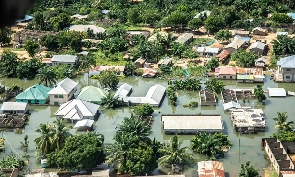 Aerial shot of the havoc caused by the dam spillage
Aerial shot of the havoc caused by the dam spillage
The Akosombo Dam, also known as the Akosombo Hydroelectric Project, which is located on the Volta River remains the last project commissioned by Osagyefo Dr. Kwame Nkrumah before his overthrow on the 24th of February, 1966.
The dam was constructed to generate hydroelectric power, facilitate irrigation, and create a large reservoir known as Lake Volta.
Construction of the Akosombo Dam officially began in 1961 and was completed in 1965.
The Akosombo Dam is a concrete gravity dam, standing 114 meters (375 feet) tall and stretching for about 660 meters (2,165 feet) across the Volta River. It created Lake Volta, one of the world's largest artificial lakes, with a surface area of about 8,502 square kilometers (3,283 square miles) when fully impounded.
The lake serves various purposes, including irrigation, transportation, and fishing.
The primary purpose of the Akosombo Dam is to generate electricity. The Volta River Authority (VRA) operates the hydroelectric power plant, which has an installed capacity of 1,020 megawatts. It provides a substantial portion of Ghana's electricity supply, supporting industrialization and economic development.
The first spill from the Akosombo Dam was in 1966. The idea of spilling water is a controlled release of excess water from the reservoir when the water level in the dam is too high.
The ability to manage water levels through controlled spillage is a crucial aspect of dam operation and safety. It ensures that the dam can handle variations in water flow and prevents the risk of uncontrolled releases that can result in flooding.
This notwithstanding has its negatives. Spilling causes lots of damage including flooding; destroying crops and livestock, displacement of communities, displacement of communities, flooding just to mention but a few.
Listening to engineers of VRA, they have been able to release about 183,000 cubic feet of water per second so far.
Even though they have been able to release 183,000 cubic they can release up to 1 million cubic feet of water if the need arises.
Currently, the water level is 277.26 feet, and the maximum operation level 277.50.
Many questions arise considering the devastating effect of this spillage.
Did the residents of Mepe and neighboring communities get informed of the spillage?
If that was the case, what measures were taken to deal with its effects?
As we speak, over 31,000 people have been displaced by the spillage causing serious livelihood challenges.
It's my considered opinion that the government of Ghana declares a state of emergency. This gives enough reason for the international community with technical expertise to come to our aid. We need to save lives and livelihoods.
Big congratulations to Ghanaians in general for their humanitarian support. Credit also goes to Samuel Okudzeto Ablakwa for the tremendous work done so far.
Going forward, VRA and the government must be more proactive in dealing with any signal regarding the rains and the water level of the dam.